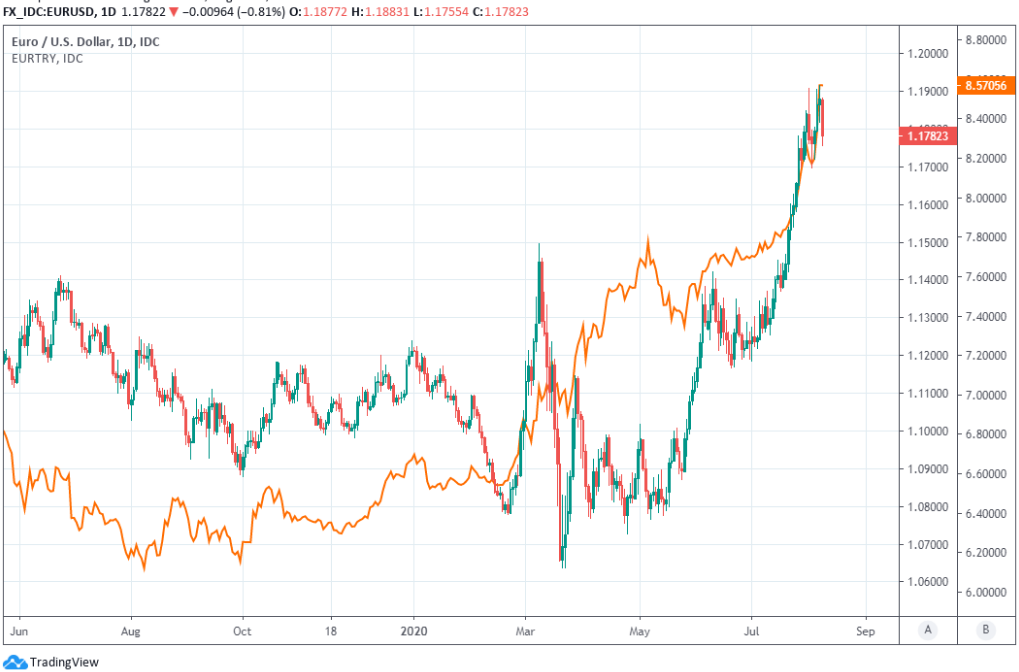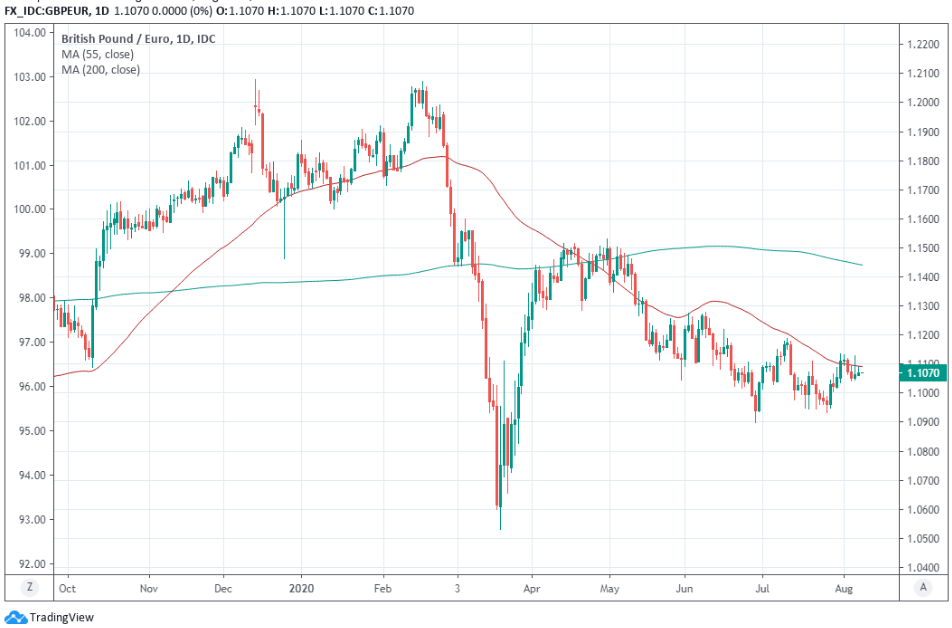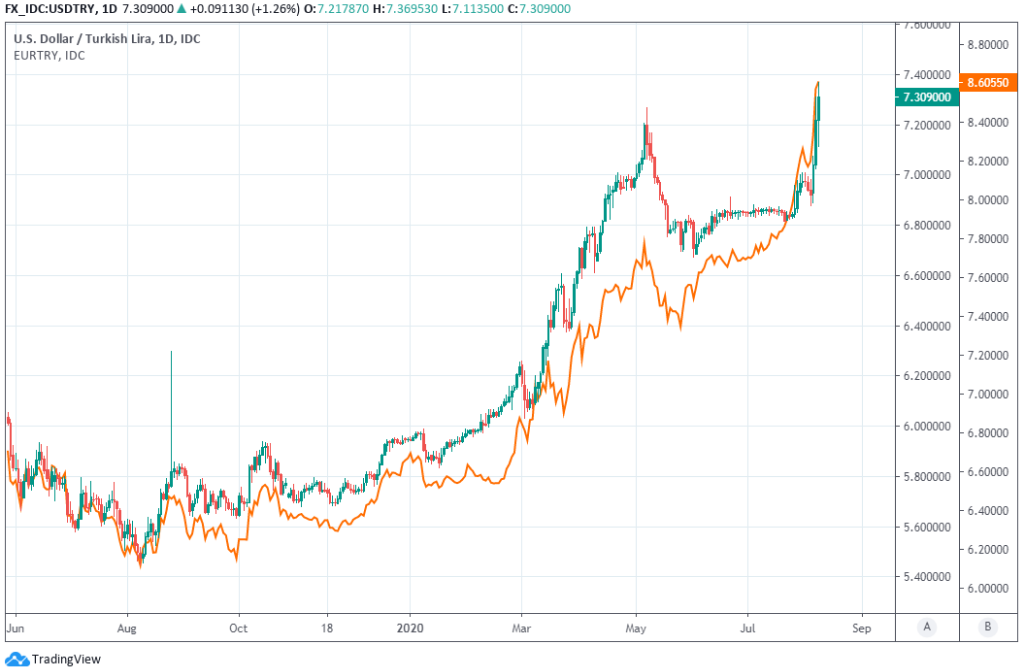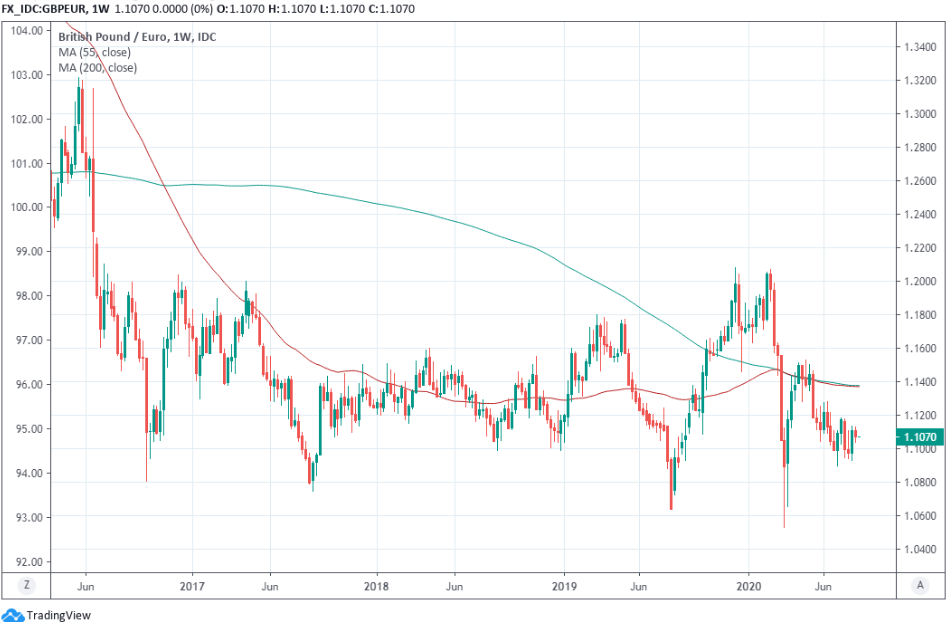Pound-Euro Week Ahead: Turkish Lira to Stoke Wider Volatility as UK GDP Data Looms
- Written by: James Skinner
- GBP/EUR consolidating in 1.10-to-1.1140 range with volatility ahead.
- Turkish currency concerns offer upside risks in a likely volatile week.
- EUR seen in driving seat as Q2 GDP, June employment data looms.

Image © Adobe Images
- GBP/EUR spot rate at time of writing: 1.1073
- Bank transfer rate (indicative guide): 1.0785-1.0863
- FX specialist providers (indicative guide): 1.0907-1.0973
- More information on FX specialist rates here
The Pound-to-Euro exchange rate has been tacking sideways in an effort to erode a multi-month downtrend but volatility could increase in the days ahead, which will see the Euro at risk in any renewed Turkish currency crisis while Sterling navigates a series of key economic reports.
Pound Sterling was one of the worst performing major currencies last week after outperforming previously, although losses were fractional against most majors especially the larger ones like the Euro. The Pound-to-Euro rate spent much of its time in a 1.10-to-1.1140 range that could widen in the coming days.
Strong support can still be found around 1.10, which is the Pound-to-Euro rate that would prevail in the event GBP/USD and EUR/USD corrected back to 1.28 and 1.1630 respectively, as some say they might.
Investor caution has built with tensions between the U.S. and China, which could see major currencies handing back recent gains over the Dollar.
"While acknowledging the market is short GBP and subject to a squeeze, we think there is outside risk of a Cable correction to the 1.2850 area, before it returns to challenge 1.32 on the weak dollar story. Any upside surprises to GDP/employment story would clearly undermine that view of a correction," says Chris Turner, regional head of research at ING. "There is outside risk that EUR/USD quickly trades down to the 1.1630/50 area – e.g. were US-China tension or continued failure over the Phase IV stimulus to trigger a stock market correction. Yet we expect willing buyers to emerge under 1.17, looking for 1.20."
A Pound-to-Euro rate of 1.10 would still leave recent lows intact although if Sterling and the single currency were to return to recent highs against the greenback, the GBP/EUR rate would still be found trading below the 1.11 handle and still within its recent narrow range. But the risk of another Turkish currency collapse is building and with it, the prospect of volatility given the Euro-to-Dollar rate is one of the primary conduits through which a tussle between Turkish authorities and the market would be played out.
Above: Pound-to-Euro rate shown at daily intervals with selected moving-averages.
"As we saw back in 2018 though, there is a risk that the impact from a more disorderly TRY sell off could be felt more broadly. EUR/USD fell by around 4 big figures during the 1H of August 2018 and subsequently weakened later in 2018," says Lee Hardman, a currency analyst at MUFG. "At the same time, there is building concern over the renewed spread of COVID-19 in Europe which could take some shine away from the EUR."
Hardman and the MUFG team have sold the Euro-to-Dollar rate and are targeting a move down to 1.16 over the coming days, which would lift the Pound-to-Euro rate as far as 1.1250 in the event that GBP/USD held above 1.30 while the Euro came under pressure.
USD/TRY and EUR/TRY surged Thursday amid speculation that authorities had abandoned efforts to prop up the ever depreciating Lira, although the exchange rates turned lower when the Turkish Banking Association was reported to be organising a coalition of locals to defend the currency.
EUR/USD is one half of the EUR/TRY rate and a primary conduit for influencing pressures on Turkey's economy, although it's also one half of the GBP/EUR rate. Gains for EUR/USD normally weigh on GBP/EUR and vice versa.
Above: Euro-to-Dollar rate shown at daily intervals alongside EUR/TRY (orange line, right axis).
"If Turkey implodes again it will be more of an issue for the EUR than the USD since some big southern European banks hold large exposures in TRY, although less materially so than in 2018. We see this as a potential trigger for a setback in EUR/USD towards the 1.1530 zone," says Andreas Steno Larsen, chief FX strategist at Nordea Markets.
Many analysts expect a new slump in the Lira to show up in EUR/USD sooner or later, which could lend the Pound-to-Euro rate an upside bias this week.
The Turkish currency has depreciated against the Dollar by around 60% per year on average in the last decade, with the depths of depreciation often seen in summer markets dominated by low volumes. In 2018 the depreciation reached crisis proportions amid a geopolitical spat with the U.S. but during the ensuing Lira sell-off, the Euro-to-Dollar rate tanked in moves that many attributed to supposed market fears about the loan exposure that European banks might have to the Turkish economy.
"Over the short run, risks to USD/TRY are skewed to the upside," says Zach Pandl, global co-head of FX strategy at Goldman Sachs. "We still think other Euro satellites should perform better, but an outright negative view on Sterling would require a more bearish macro backdrop."
Above: USD/TRY rate shown at daily intervals alongside EUR/TRY (orange line, right axis).
With Turkish currency risks aside the Pound-to-Euro rate will take its lead from second quarter GDP data and unemployment numbers for June, although Sterling might be more sensitive to upside surprises than disappointments given the extent to which bearish sentiments toward the UK economy have already weighed on the British currency in recent months. Job numbers are out Tuesday at 07:00 while GDP data is due out at 0:700 Wednesday.
"Among the EU’s big 4, Spain performed the worst dropping by 18% q-o-q. We think the UK will fare far worse. We expect growth to shrink by 22% q-o-q," says Sanjay Raja, an economist at Deutsche Bank. "The Q2 national accounts will paint one of the ugliest pictures of the UK economy ever."
Investors may pay more attention to the GDP data given how the government furlough scheme has kept the official unemployment rate suppressed. Consensus looks for the latter to rise from 3.9% to 4.2% for the month of June on Tuesday while favouring a -20.5% contraction that would put the UK at the bottom of the developed world league table in terms of economic performance.
"Unless there is a broader deterioration in overall investor risk sentiment, the GBP appears well placed to extend its advance in the near-term," says MUFG's Hardman. "If cable is able to break above the 1.3200 where the highs from earlier this year are located, it will open the door to a potential test of the December 2019 high at close to the 1.3500. We would become more confident in further near-term GBP gains if EUR/GBP was able to break more decisively back below the 0.9000-level."
Above: Pound-to-Euro rate shown at weekly intervals with selected moving-averages.







